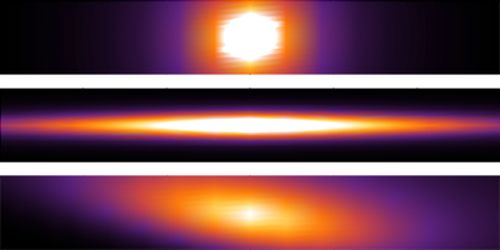Scientists Propose the Potential Existence of Alternative Forms of Dark Matter
A team of Harvard University physicists has proposed the possible existence of a type of dark matter not described by current physics models. In their paper published in the journal Physical Review Letters, the team suggests it’s possible that not all dark matter is cold and collision-less.
In the visible universe, galaxies form into a disk shape—the Milky Way is a good example. All of its members align roughly along a single plane, this due to the forces of gravity and spin. Objects form into masses which, over time, spread out into a disk shape. Dark matter, on the other hand, appears to hover around galaxies like a halo, at least according to current models. It’s seen as dark, cold and with so little energy that dark matter particles rarely if ever run into one another. The researchers in this new study suggest there may be other types of matter, however, that behaves more like visible matter. And, because of that, they suggest it could bunch up due to dark-matter-type gravity and form disks as well. These disks, which they describe as dark matter component double-disk dark matter, could represent as much as 5 percent of all existing dark matter.

For dark matter to clump, it would need to have other properties similar to visible matter as well. For that reason, the researchers suggest it’s possible that there exists dark atoms, dark photons, and likely some form of dark electromagnetic force as well.
Research on dark matter over the years has led to a model that describes dark matter as existing in a ball shape—galaxies sit in the middle of the ball, which would mean observers living in a galaxy would “see” it as existing everywhere around them. But it’s possible that other types of shapes exist as well, the researchers suggest, because there are other types of matter in the visible universe. They note that baryonic matter (matter made of strongly acting fermions known as baryons) is believed to make up approximately 5 percent of all matter in the known universe. For that reason, they conclude that it would appear likely that similar differences in dark matter would occur as well, and perhaps in nearly equal proportions.
If true, it would mean there could be whole dark galaxies out there, undetectable, yet as real as those we can see with the naked eye. Much more research will have to be done in this area before adding such types of dark matter to models in general use, of course. Until then, it will remain an abstract theory.
This article is republished from PhysORG under a Creative Commons license. Read the original article.*
Do not forget to share your opinion with us to provide you with the best posts !



0 Comments